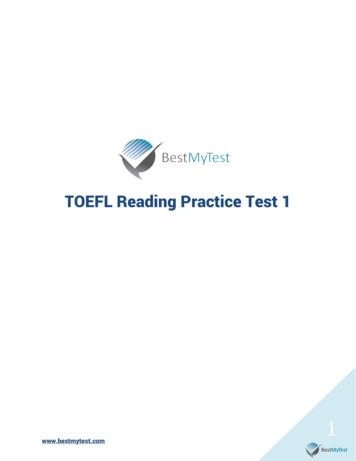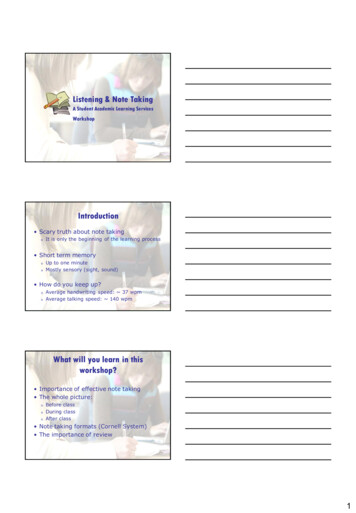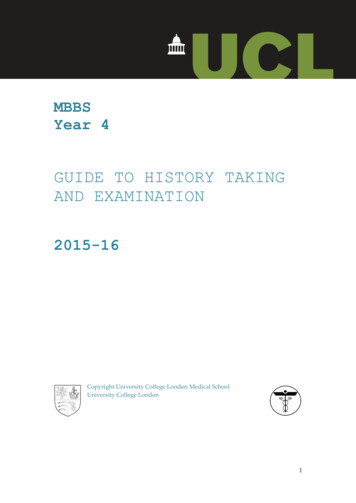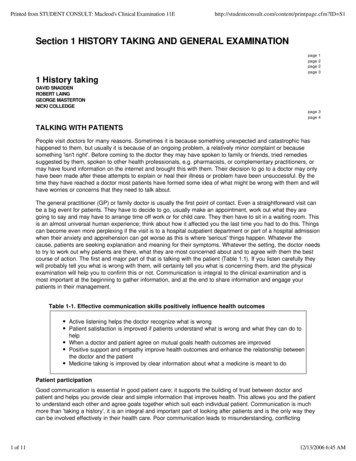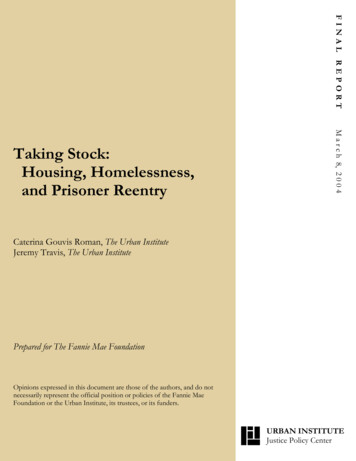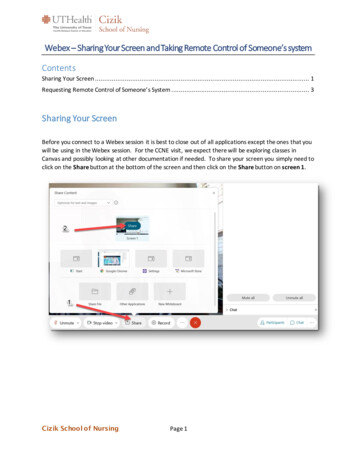
Transcription
785TOEFL Note Taking and Answer StrategiesPatrick Rates, Rikkyo University, JapanAbstract: This paper will describe a comprehensive TOEFL iBT course for EFLstudents at a Japanese university which students were taught note taking and answerstrategies with answer templates. This paper will provide an outline of a method ofnote taking and answer strategies for the reading writing, listening and speakingsections of the test. Knowing that some students would be taking the TOEFL iBT inthe near future in order to study abroad as part of exchange programs, the class wasdesigned to be based around improving the students’ test taking ability for the test.This paper will describe how the class was set-up implemented the class; this paperwill discuss problems that encountered and what we did to overcome them. Thispaper will also share student feedback from an end-of-the-semester survey andinterviews. Finally, I will make specific recommendations to other educators hopingto use this teaching method in the classroom in a similar way. The purpose, therefore,of this paper is to share what I did in this class and what I learned, in the hope that itmay be beneficial to other educators interested in this type of strategies to improvetheir students’ reading writing, listening and speaking abilities or for TOEFL iBTtraining.Keywords: TOEFL, Note Taking, Answer strategies, TemplatesIntroductionThe goal of this paper is to provide a strategy approach to the TOEFL test.Developing student strategies and applying these strategies into reading, listening,speaking, and writing. The reason I decided to take this approach for this class wasthat I was assigned to teach an advanced comprehensive TOEFL class that was toteach all four skills for the TOEFL test. The class met once a week for ninety minutesfor fourteen weeks. The challenge that I saw in this class was that I would have littletime to spend on each of the four skills. Instead of focusing on improving their fourlanguage skills, I decided to focus on the skills that the students already had and tofocus on note taking and answer strategies. When appropriate, using note takingtemplates and answer templates for each question. My reason for this approach wasthat it would give the students an opportunity to have experience with each question,knowing what to expect and have a note taking and answer strategy for each question.By using these strategies, note taking skills and templates, students would know whatto expect for each question. This allows the student to predict typical outcomes andresponses to situations.Using this method, other than teaching strategies for each section of the test, I hopedto teach the students to take clearly organized notes that at times could be used inresponse scripts. Notes that are clearly organized and only need to be inserted thenotes into an answer script. Most of the scripts usually include a first sentence to theanswer and a structure of how to organize their answer. Such a strong first sentencemakes the student more confident to give the rest of their answer. The scripts alsoprovide structure to the students answer, this way the student does not have to thinkabout how they are going to organize their answer. The template organizes the answerfor the student; the student only has to fill in the empty spaces on the template.
786I found note taking and template strategies to be valuable because it is not enough toknow what to do, but it must be done quickly and correctly.TOEFL ExamEvery year almost a million people across one hundred sixty five countries take theTOEFL exam (Educational Testing Service, 2010) as part of their efforts to secureadmission to schools of their choice, win scholarships, gain professional accreditation,apply for visas, etc. Described as a test aimed at “measuring non-native speakers’ability to use English to communicate effectively in college and university settings,” itis used by over six thousand colleges and universities world- wide, as well as bygovernment organizations and agencies (Riley & Wyatt, 2009).Whether or not we, as language educators, believe the TOEFL to be an accuratemeasure of a learner’s true command of the English language, or even whether wedisagree with the whole premise of a worldwide, standardized English test(McCrostie, 2006) or its inevitable wash back effect in language education (Bailey1999; Cheng, 2008), the practical value of the TOEFL to young, ambitious people isreal: they simply need a good TOEFL score to open the doors necessary to realizingtheir future dreams. In addition, the types of skills required in the test (i.e., thereformulation of arguments heard in lectures in both written and spoken discourse)might well be skills required in future studies or careers.The TOEFL iBT was introduced in 2005 as an alternative to the TOEFL paper-basedand computer-based versions, which had already been in use. Because the iBT is afour skills test, it responded to criticisms of TOEFL lacking a speaking component(Powers, 2010). There was also a reformulation of the tasks in the TOEFL iBT tocorrespond to the actual skills required of students in an English-language academicsetting (e.g., the integrated writing and speaking task), rather than the testing ofdiscrete knowledge about forms of the English language that could be coached,leading to negative wash back effects on teaching and learning. In addition, by beingInternet based, the iBT offers flexibility for candidates who can now take the TOEFLwith greater regularity and even make multiple attempts over a relatively short span oftime. Without a doubt, the TOEFL iBT remains a popular measure of a student’sEnglish ability by academic institutions in North America and around the world(Ohkubo, 2009).My Comprehensive TOEFL ClassJapanese takers of the TOEFL test historically tend to rank toward the bottom of testtakers in Asian countries (Hagerman, 2009) and most recently have continued thattrend (Educational Testing Service, 2009 b), because of this, there is support for theidea that in Japan there is a need for new, innovative methods for TOEFL training.My TOEFL, class was an elective course, which students had to have a certain levelof English skill based on the university in-house English test to enter the class. Theclass was made up of 12 students. As might have been expected for a high-level class,a few of the students had actually lived abroad as children, while others had done oneyear home stays in high school.
787Lesson FlowMy general plan for the course was to have students begin each class with selfdirected study on vocabulary for 10 minutes, and then use the remaining class time tofocus on note taking and answer strategies for the iBT TOEFL test. For each class Iwould generally focus on one of the question types from one of the skills.In the fourteen weeks of the class, we covered all for sections of the test. Next, Iwould like to explain the general note taking strategy and answer strategy whilelooking at the general content, goals and flow of each section of the lesson. Figure 1presents a sample lesson print that students received for reference and for practice.The lesson provided information for students on a specific skill set of a specific skill.The lesson contains an overview of the section; advise for students, note-takingstrategies, response scripts, and in class practice.TOEFL Speaking – Sample lessonTOEFL Speaking Overview The TOEFL speaking section contains 6 questions that you answer with recordedspeech The maximum possible score on this section is a 30 Graders are trained to rate your recordings according to strict requirements andwill assign each of your answers either a 1, 2, 3, or 4 depending on the qualityand strength of your answer A 1 is uncommunicative; students who earn this score may have survivalEnglish but nothing more. A 2 is limited; this is for students who can survive comfortably with Englishbut cannot express themselves very well. A 3 is communicative; students with this score are comfortable with Englishand have next to no limitation with the language. A 4 is nearly fluent; this is awarded to students who display a fluent commandof the language Does your accent affect your score? It does matter if there are points in yourspeech that are unclearQuestion 1 and 2: These questions ask for your opinion. Next, you are given 15 seconds to prepare your answer. After that, you have 45 seconds to speak. A clear, fluent, and organized answer is best.1.15 Seconds preparationHelpful phrasesIn my view . . . for the two reasons . . .First, . . . for example . . .Second, . . . for instance . . .That’s why . . .
7882.In my view . . . for the two reasons . . . Give your answer to the question in one simple sentence. Use the question to help you form your answerFirst, . . . for example . . . Give your first reason. Make it a very short simple answer. When you finish, give your example. Make your example specific to the answer, Use where, when and whoSecond, . . . for instance . . . Give your first reason. Make it a very short simple answer. When you finish, give your example. Make your example specific to the answer, Use where, when and whoThat’s why . . . Restate the question3.ExampleWhat do you consider the most important characteristic in a teacher? Use specificexamples to support your idea.A knowledgeR1 learn moreR2 funIn my view, knowledge is the most important characteristic in a teacher for tworeasons. First, you learn more. For example, when I was in university, in NewYork, I had a professor in chemistry class. He knew is subject very well and hislectures were good because he provided us many details.Second, it’s more fun. For instance, when I was in history class in California, I hada history teacher who knew a lot about World War Two. The examples were so goodthat, I just enjoyed it very much.That’s why knowledge is important.*If you can’t think of two reasons, then give two examples.Figure 1.
789Integrated ReadingOn the TOEFL iBT reading section, students will read several reading passages, someof which can be up to 750 words long. Taking notes on these reading passages willincrease their reading comprehension and will help them to answer the questions,especially those involving charts and schematic tables.If students have trouble with timing, it's a mistake in strategy. It is important forstudents to follow a timeline to best distribute effort on each question, not spendingtoo much time on one individual question. As students answer, they will always beable to jump to different questions and spend more time at the end on questions thatthey were unsure of the answer.It is important that students don’t read the whole passage before they start answeringthe questions; if they do, it will be a very inefficient and time-wasting way to read.Instead, students should acquire a basic idea of the reading and prepare their mind forwhat you’re going to read about by first reading the title. Then, read the first sentence(which is the all important topic sentence) of every paragraph. Do this to get a quickintroduction to the reading before you read it in detail.Only spend 1 minute doing this. Anymore than that and it will be too much time,spend all of the time that they can answer the questions since that’s where your scorecomes from. To finish within one minute, students might have to read only pieces ofthe first sentences (subject, verb, object only) since they can be quite big.After they read the first sentence, students should read question number one, not theanswers but the question. Establish an idea of what it’s asking about in the answer.Then, start reading the passage from the very beginning in search of the answer to thatquestion. In this way, they will concentrate only on what’s important and what willearn them a higher score.Once they answer question number one, go onto question number two in the sameway. The TOEFL questions proceed in chronological order, so the answer to numberone is in the beginning of the passage and the answer to number twelve is towards theend.Integrated WritingIn the writing section, students are shown a short reading and given three minutes toexamine it and take notes. Then, they listen to a short lecture or spoken opinion (2–3min.) on an academic subject, while taking notes. Finally, they are shown the readingagain and are given 20 minutes to compose a response on the computer in the form ofa short essay, attempting to integrate content from both the lecture and the reading.On the writing section, students will have 20 minutes to explain how an academicreading and listening passage are related. Using notes, students will summarize thetwo sources and explain how they are related. To achieve a high score on this section,they will need to rely on their notes as they answer the writing task.In this section as in other sections, content is important, not mechanics. This meansthat poor content and great mechanics will yield a fair to low score and great contentand poor mechanics will yield a fair score. In other words, strong content has morepower over the score than mechanics.
790Of course, students need good mechanics, but too many students study grammarinstead of develop listening skill and overall writing skill in preparation for theTOEFL writing section, which is a massively ineffective way to study. Contentmastery first and writing mechanics second. Notes are very important in this section.First, it’s all about your notes and understanding. Once students have all of theimportant content, that’s all they need.Integrated ListeningFirst in the listening section, students must take good notes as listen activelythroughout the entire listening. Many students struggle with this. They take either nonotes, so they miss important information--or too many notes--so they sacrificeunderstanding and comprehension. Students need to practice and build the skill andimprove their note taking s
The template organizes the answer for the student; the student only has to fill in the empty spaces on the template. 786 I found note taking and template strategies to be valuable because it is not enough to know what to do, but it must be done quickly and correctly. TOEFL Exam Every year almost a million people across one hundred sixty five countries take the TOEFL exam (Educational Testing .
